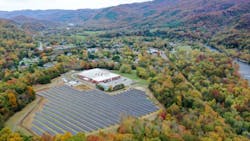MGK Editor's Take 9/18: Burying the Microgrid Hatchet and Moving Forward with Utilities
Last week while attending RE+ in Las Vegas, I was fortunate to meet a lot of amazing people doing incredible work in the microgrid sector. And I saw a lot more people than I met, which is what happens at conferences. I find it useful to shut up and listen.
The result was loud and enthusiastic. RE+ is not solely about microgrids but rather the clean energy transition as a whole, which makes sense considering the forces behind one of the biggest such events are the Smart Electric Power Alliance and the Solar Energy Industries Association. Renewables, energy storage, virtual power plants, hydrogen, interconnection challenges, financing, regulations and supply chains made for gripping subject matter as developers, manufacturers, suppliers and, oh yes, customers talked about navigating the future of decarbonization.
Another group there, perhaps smaller in numbers but no less important, was made up of electric utilities, including Duke Energy, Pacific Gas & Electric (PG&E), Sacramento Municipal Utility District and Commonwealth Edison based in Chicago. These utilities span the U.S. from coast to coast and show that the industry is serious about exploring its future with microgrids.
Generate Capital and SunEdison founder Jigar Shah, now director of the U.S. Department of Energy’s Loan Programs Office and a veritable rock star at RE+, pointed out the multiyear interconnection queues for distributed energy resource (DER) projects and how parties need to work together on merging macro with micro. (Speaking of the DOE, Kathy Hitchens writes about its collaboration with the National Renewable Energy Laboratory on microgrids and clean energy strategies).
“Part of the conversation is burying the hatchet with utilities,” Shah said, and he didn’t mean in each other’s backs. “Utilities are ready to embrace a lot of new technology out there.”
A story by Lisa Cohn highlights work involving PG&E, Portland General Electric, San Diego Gas & Electric and Florida Power & Light, among others. Utility microgrids certainly still constitute a small minority of capital expenditures, but the trend line is going up.
Synthetic Inertia: A Solution to DER Growing Pains in Texas: White Paper by PXiSE Energy Solutions
Microgrids are expensive to locate, build and connect, but many grid planners and utilities see returns in the avoided costs of larger transmission and distribution system spends. A million dollars here and there can perhaps save $15 million or more elsewhere on the system where it makes sense to focus on DERs.
No doubt the microgrid future is promising, given how much the recent past has taught us about climate change impacts and grid resiliency. The Electric Reliability Council of Texas, which manages the grid in fossil fuel-proud Texas, is working on pilots to incorporate virtual power plant and greater distributed energy resource input to offset incessant record peak demand straining the main system.
Utilities are on board with resiliency – always have been and likely always will be if they want to stay in business. Building relationships between macro and micro can be awkward and halting, same as it is around the expanding electric vehicle charging infrastructure future. Make no mistake, though, microgrids will need utilities, at least in many places. More importantly, those smart utilities will need microgrids.
Editor's Note: This column was originally posted as the intro for Monday, Sept. 18 Microgrid Knowledge Newsletter. Track news about microgrids. Subscribe to the free Microgrid Knowledge Newsletter.
About the Author
Rod Walton, Microgrid Knowledge Managing Editor
Managing Editor
For Microgrid Knowledge editorial inquiries, please contact Managing Editor Rod Walton at [email protected].
I’ve spent the last 15 years covering the energy industry as a newspaper and trade journalist. I was an energy writer and business editor at the Tulsa World before moving to business-to-business media at PennWell Publishing, which later became Clarion Events, where I covered the electric power industry. I joined Endeavor Business Media in November 2021 to help launch EnergyTech, one of the company’s newest media brands. I joined Microgrid Knowledge in July 2023.
I earned my Bachelors degree in journalism from the University of Oklahoma. My career stops include the Moore American, Bartlesville Examiner-Enterprise, Wagoner Tribune and Tulsa World, all in Oklahoma . I have been married to Laura for the past 33-plus years and we have four children and one adorable granddaughter. We want the energy transition to make their lives better in the future.
Microgrid Knowledge and EnergyTech are focused on the mission critical and large-scale energy users and their sustainability and resiliency goals. These include the commercial and industrial sectors, as well as the military, universities, data centers and microgrids. The C&I sectors together account for close to 30 percent of greenhouse gas emissions in the U.S.
Many large-scale energy users such as Fortune 500 companies, and mission-critical users such as military bases, universities, healthcare facilities, public safety and data centers, shifting their energy priorities to reach net-zero carbon goals within the coming decades. These include plans for renewable energy power purchase agreements, but also on-site resiliency projects such as microgrids, combined heat and power, rooftop solar, energy storage, digitalization and building efficiency upgrades.

